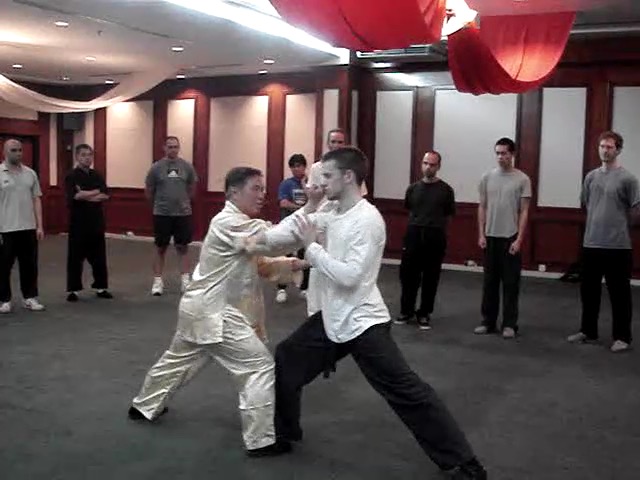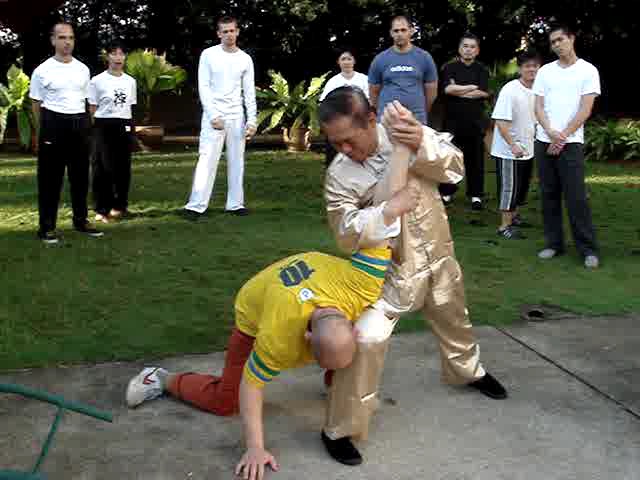WHAT IS FIRST CLASS KUNGFU?

What is First Class Kungfu?
Question
Is kungfu mainly for destroying?
How does a practitioner know if his or her kungfu destroys life?
What about wushu? As it does not train combat efficiency can it even be called fourth-class Kungfu?
What are examples of the various classes?
What kinds of skills are there in the various classes?
Can first-class kungfu destroy life or is it impossible?
Are there no benefits of training third-class kungfu?
Are all iron trainings (iron palm, iron leg, iron shirt etc.) third-class kungfu?
Is training with a wooden dummy third-class kungfu?
As we have chi flow in our school does it make our kungfu to first-class kungfu or are there other important things to consider?
We learn to attack and defend ourselves. Is attacking third-class kungfu?
— Bernhard, Austria
Answer
Bernhard’s questions, which appeared in our Shaolin Wahnam Discussion Forum, are very interesting and there are many interesting answers in the Forum.
Here are my answers.
Whether kungfu is mainly for destroying depends on the practitioner. For us in Shaolin Wahnam, the main purpose of practicing kungfu is to enrich our lives and the lives of other people. I am glad that our Shaolin Wahnam kungfu practitioners are healthy, full of vitality, have longevity, have mental clarity and spiritual joys.
A practitioner knows whether his or her kungfu destroys life when it destroys life. In other words, he knows from direct experience, just as he (or she) knows he is happy when he is happy, or he knows he sits on a chair when he sits on a chair.
"Wushu" as most Westerners know it today is a magnificent demonstrative art. There is no combat training, no internal force training and no spiritual cultivation. But “wushu” in Chinese means “martial art”, or what is understood in the West as “kungfu”.
As there is no training for combat efficiency in wushu, I would not even call it fourth-class kungfu. Nevertheless, what many kungfu practitioners practice today also does not involve combat efficiency. They only practice kungfu forms, and if they have to spar, they would borrow techniques from other martial arts.
Traditionally, kungfu is classified into three classes. Third class kungfu deals with combat. Second class kungfu deals with combat and health. First class kungfu deals with combat, health and spiritual cultivation.
I hesitate to give examples of various classes as it may be sensitive. It depends much on the teacher and the practitioner. A poor teacher and a poor practitioner who focus only on the combat of any style of kungfu would make it third class. An excellent teacher and an excellent practitioner can make the same style of kungfu first class when they also focus on health and spiritual cultivation besides combat.
I am proud that any style of kungfu practiced in our school, Shaolin Wahnam, is first class. It is not just a wild claim; it can be easily verified from experience. Our kungfu students are combat efficient, healthy, and peaceful and happy.
Kungfu if practiced correctly is at least second class. It provides combat efficiency and good health. Unfortunately, many kungfu practitioners today do not even know how to apply their kungfu for combat.
The kind of skills are related to the class of kungfu. For third class kungfu, students should learn combat skills like timing and spacing, and force training. For second class kungfu, students should learn to be relaxed and be focused, so that they can have good health. For first class kungfu, students should learn to be peaceful and happy.
First class kungfu can destroy life, as the development is progressive. In other words, first class kungfu includes attainments of second class and third class kungfu.
There are benefits of training third class kungfu. It may, for example, save your breakfast from being snatched away.
Whether all iron training like Iron Palm, Iron Leg and Iron Shirt is third class, second class or first class kungfu depends on how it is being trained. If it is just used for combat, often at the expense of health, it is third class kungfu. If the training contributes to health, it is second class kungfu. If it contributes to spiritual cultivation, it is first class kungfu.
It is the same as training with a wooden dummy. However, it may need much thought and ingenuity to train a wooden dummy for health and spiritual cultivation. Generally, it is third class kungfu if the training can be used for combat. It is not even third class kungfu if it can’t contribute to combat efficiency.
Chi flow will contribute to good health, vitality and longevity. It will at least make our kungfu second class if we also know combat. However, if we just have chi flow but do not know combat, like our chi kung students, we cannot even call it third class kungfu.
If our chi flow contributes to our spiritual cultivation, like making us happy and peaceful, our kungfu becomes first class.
It is necessary to consider other important things besides knowing chi flow. We need, for example, to know the philosophy besides having the techniques and skills of breaking blockage resulting in overcoming illness, having harmonious chi flow resulting in good health, making the chi flow vigorous resulting in vitality, having a lot of chi to flow for a long time resulting in longevity, clearing and nourishing the intellect resulting in mental freshness, and nourishing the spirit resulting in being peaceful and happy.
Learning to attack and defend is combat training, which makes our kungfu third class. It is the most basic of kungfu. If one cannot attack or defend, he cannot call his art kungfu. But we do not just attack or defend, we also have health and spiritual cultivation, which make our kungfu first class.

First class kungfu is not only good for combat, but also for health and spiritual cultivation
LINKS
Reproduced from Questions 4 in Selection of Questions and Answers October 2019 Part 1
